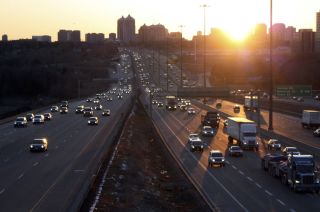
www.buildingsandcities.org/insights/commentaries/construction-management-research-consequences.html
Construction Management Research: The Challenge of Consequences

Challenges ahead: why research must focus on potential problematic consequences and provide proactive built-in fail-safes
Everything has consequences. Indeed, a fundamental goal of much construction management (CM) research is precisely to create consequences and bring about positive change. However, exactly how such consequences will manifest is not always predictable, which also makes them highly challenging. Fred Sherratt (University of Colorado, Boulder) explains why CM research needs to shift its focus from questions of 'if we can' to 'if we should' in order to embrace consequential consideration.
The challenge of consequences is something that the CM research community has always faced; but we're not always very good at dealing with it. As Leiringer & Dainty (2023) argue, there is a tendency for CM researchers to look inwards, to remain within a 'CM bubble', and thus fail to incorporate knowledge from outside our specific field. The consequence of this myopic situation is that CM researchers often fail to consider the context within which their research sits, and thus any wider implications and potential consequences of implementation at local, national and global levels.
As an example, most recently the CM research community has been directed towards enabling technological solutions promoted by funders and little else (Green 2022). The innovations of this forth digital industrial revolution (often termed Construction 4.0) may well have the potential to deliver technological solutions to many long-standing construction industry problems. However, many of the likely and associated potential consequences remain neglected within such research. This narrow framing is problematic as it fails to sufficiently identify (and help resolve) issues that can arise.
An already diagnosed case of such 'consequential myopia' can be found in the use of wearable sensor technologies for construction safety (Sherratt et al. 2023). Many researchers of such technologies take the position that technology is neutral, and this 'neutrality' seems to absolve researchers from ever considering the wider consequences of their research - intended or not. Despite the fact that wearable sensors will enable managers to monitor worker locations, movement, health, fatigue, gait and much more - if the ostensible goal is 'safety', it seems no other consequences need be considered. However, will the fact that wearables will also gift firms with the ability to see who their most 'productive' workers are also eventually lead to the 'removal' of the lowest performing? Will workers be prevented from even starting work based on whether an AI algorithm says they are tired or not, resulting in the withholding of an expected day's pay? Such consequences may not seem important to CM researchers, but they certainly will be to workers should they be realised. Yet consequences of this nature are rarely noted and are certainly not given shared consideration in such research, despite the fact that all wearables, no matter what they purport to be monitoring, inevitably provide a readily exploitable 'digital exhaust' (Zuboff 2019).
Instead, CM research tends to focus on how to encourage workers to accept and use such technologies, rather than the prevention of their exploitation by management. This is despite non-CM research - carried out by the UK Government no less in their examination of delivery fulfillment centers - empirically demonstrating that the constant monitoring of workers is really bad for their mental health (APPG 2021). Given the current poor state of mental health in the construction industry (Nwaogu et al. 2019), it would be highly appropriate for research to assess these impacts before we rush to delivery. And that's before the weak ethical record of the UK construction industry is even considered, as the blacklisting scandal of 2009 all too clearly revealed (UK Parliament 2016). All of this begs the question of why such contextual considerations are overlooked when the situation is both potentially deleterious for worker mental health and ripe for exploitation with those in power holding such a strong track record of exploiting? It seems that potential consequences in this space are sidelined by CM researchers in their rush to secure funding, deliver solutions and, more cynically, to pioneer eminently commodifiable findings.
Another area of research where consequences are now much more foreseeable than they perhaps once were, is the digitisation of delivery platforms, production monitoring and payments through interlinked blockchains (Elbashbishy et al. 2022). Blockchains have been heralded as a solution to the lack of trust and transparency in the construction industry, providing a technology able to monitor, distribute, store and share secure data, all the while creating a seemingly honest record of the project. Yet putting such trust in automatic systems should no longer be as reassuring as it once was. The UK Post Office Horizon Scandal, in which a similar 'incorruptible' computer system was fundamentally corrupted and through hostile leadership ultimately resulted in its victims being falsely imprisoned, societally ostracised, and in some cases even driven to suicide (UK Government 2024). Creating a complete digital system with fully transparent processes from design to construction to operation, all governed by technology might seem like a dream solution for a highly risk averse, litigious, and adversarial industry, but we should not be so naive to think that such technology is infallible. Nor that those in control will always be honest about such failings.
Indeed, when the details of such systems are investigated, other potential consequences start to emerge. If a site team develops and installs a solution for a problem that wasn't spotted in the BIM model, does it even exist? Can they get paid for work if none of the 3D, 4D or 5D BIM layers can find it? What about the time it took to plan the solution - can the AI site surveillance discern when the team was talking about site? Will workers get docked for unproductive time? And what about when Jack had to go offsite to get the materials for the fix? Will we get penalised for fewer workers on site than planned, as there isn't an option on the turnstiles for 'going to get stuff the design team didn't realise we needed' to log out with? It might well be awesome that we can be told to the second when we looked at the drawings online, and that the Request For Information (RFI) we raised to query the detail was closed at precisely 4:32pm - but that won't help if the answer was incomplete and there was no button to report that back to the system. The system said it was complete and closed, so it must be completed and closed satisfactorily - because otherwise it wouldn't be closed, would it? And there's no way the QS is going to get involved as manual changes would undermine the digital security of the system as a whole. This is why Kafka matters! And why CM researchers should ask much more awkward questions of their work, to hold up a mirror to current practice (Leiringer & Dainty 2023) and ensure potential consequences are duly considered before rushing to prescribe technological solutions without caveat.
These consequences present some of the challenges the research community is already facing and will continue to face as technologies emerge or become entrenched. The challenge for the research community is to acknowledge, accept and own the consequences - intended and unintended - of what we do. To think more broadly about the contexts in which such technologies operate and expand our horizons with the human valorised over the process or product. At present, focus very much remains on if we can, instead of if we should. Whilst curiosity is a vital trait of any good CM researcher, the strive to 'if we can' does not excuse a lack of consequential consideration. The role of research is not to be complicit in the continuation of a terribly unequal world. Instead, research (and the researchers involved) should strive to deliver research that supports ethical practices, equality, equity and social justice as well as reduce and limit imbalances of power and control. The first step is to investigate the wider social, economic and environmental impacts - both for the short and long term.
To that end researchers must be more cognisant of consequences when bidding for, planning, undertaking and disseminating research. It is appropriate for some research to advocate for not doing something because of the potential negative consequences that could result, although funders and journal editors may need to be better educated to be content with such findings. Research is also needed that specifically investigates potential problematic consequences and provides proactive built-in fail safes for problematic processes or products. This is vital in an applied field such as construction management, where consequences do matter - be they intended or not.
References
APPG on the Future of Work (2021). The New Frontier: Artificial Intelligence at Work, UK Government All-Party Parliamentary Group final report. https://www.ifow.org/publications/new-frontier-artificial-intelligence-work
Elbashbishy, T.S., Ali, G.G. & El-adaway, I.H. (2022). Blockchain technology in the construction industry: mapping current research trends using social network analysis and clustering. Construction Management and Economics, 40(5), 406-427. https://doi.org/10.1080/01446193.2022.2056216
Green, S. (2022). Modern methods of construction: reflections on the current research agenda, Buildings and Cities, 3(1), 653-662. https://journal-buildingscities.org/articles/10.5334/bc.265
HM Treasury. (2018). PFI and PF2, HC 718. London: National Audit Office.
Leringer, R. & Dainty, A.R.J. (2023). A Research Agenda for Construction Management. Elgar Publishing Ltd.
Nwaogu, J.M., Chan, A.P., Hon, C.K. et al. (2019). Review of global mental health research in the construction industry: a science mapping approach, Engineering, Construction and Architectural Management; 27(2): 385-410. https://doi.org/10.1108/ECAM-02-2019-0114
Sherratt, F., Wong, P. & Sherratt, S. (2023). How construction safety academics are researching wearables for safety, and why it matters, Proceedings of the CIB W099/123 Annual Conference - Digital Transformation of Health and Safety in Construction, Porto, Portugal, 21-22 June 2023.
UK Government. (2024). Policy Paper: Horizon scandal factsheet: Post Office (Horizon System) Offences Bill. https://www.gov.uk/government/publications/post-office-horizon-system-offences-bill-supporting-documents/horizon-scandal-factsheet-post-office-horizon-system-offences-bill
UK Parliament. (2016). Blacklisting Compensation Payments. https://edm.parliament.uk/early-day-motion/49298
Zuboff, S. (2019). The Age of Surveillance Capitalism: The Fight for a Human Future at the New Frontier of Power. Profile Books
Latest Peer-Reviewed Journal Content
A framework for 1.5°C-aligned GHG budgets in architecture
G Betti, I Spaar, D Bachmann, A Jerosch-Herold, E Kühner, R Yang, K Avhad & S Sinning
Net zero retrofit of the building stock [editorial]
D Godoy-Shimizu & P Steadman
Co-learning in living labs: nurturing civic agency and resilience
A Belfield
The importance of multi-roles and code-switching in living labs
H Noller & A Tarik
Researchers’ shifting roles in living labs for knowledge co-production
C-C Dobre & G Faldi
Increasing civic resilience in urban living labs: city authorities’ roles
E Alatalo, M Laine & M Kyrönviita
Co-curation as civic practice in community engagement
Z Li, M Sunikka-Blank, R Purohit & F Samuel
Preserving buildings: emission reductions from circular economy strategies in Austria
N Alaux, V Kulmer, J Vogel & A Passer
Urban living labs: relationality between institutions and local circularity
P Palo, M Adelfio, J Lundin & E Brandão
Living labs: epistemic modelling, temporariness and land value
J Clossick, T Khonsari & U Steven
Co-creating interventions to prevent mosquito-borne disease transmission in hospitals
O Sloan Wood, E Lupenza, D M Agnello, J B Knudsen, M Msellem, K L Schiøler & F Saleh
Circularity at the neighbourhood scale: co-creative living lab lessons
J Honsa, A Versele, T Van de Kerckhove & C Piccardo
Positive energy districts and energy communities: how living labs create value
E Malakhatka, O Shafqat, A Sandoff & L Thuvander
Built environment governance and professionalism: the end of laissez-faire (again)
S Foxell
Co-creating justice in housing energy transitions through energy living labs
D Ricci, C Leiwakabessy, S van Wieringen, P de Koning & T Konstantinou
HVAC characterisation of existing Canadian buildings for decarbonisation retrofit identification
J Adebisi & J J McArthur
Simulation and the building performance gap [editorial]
M Donn
Developing criteria for effective building-sector commitments in nationally determined contributions
P Graham, K McFarlane & M Taheri
Reimagining circularity: actions for optimising the use of existing buildings
R Lundgren, R Kyrö, S Toivonen & L Tähtinen
Effective interdisciplinary stakeholder engagement in net zero building design
S Vakeva-Baird, F Tahmasebi, JJ Williams & D Mumovic
Metrics for building component disassembly potential: a practical framework
H Järvelä, A Lehto, T Pirilä & M Kuittinen
The unfitness of dwellings: why spatial and conceptual boundaries matter
E Nisonen, D Milián Bernal & S Pelsmakers
Environmental variables and air quality: implications for planning and public health
H Itzhak-Ben-Shalom, T Saroglou, V Multanen, A Vanunu, A Karnieli, D Katoshevski, N Davidovitch & I A Meir
Exploring diverse drivers behind hybrid heating solutions
S Kilpeläinen, S Pelsmakers, R Castaño-Rosa & M-S Miettinen
Urban rooms and the expanded ecology of urban living labs
E Akbil & C Butterworth
Living with extreme heat: perceptions and experiences
L King & C Demski
A systemic decision-making model for energy retrofits
C Schünemann, M Dshemuchadse & S Scherbaum
Modelling site-specific outdoor temperature for buildings in urban environments
K Cebrat, J Narożny, M Baborska-Narożny & M Smektała
Understanding shading through home-use experience, measurement and modelling
M Baborska-Narożny, K Bandurski, & M Grudzińska
Building performance simulation for sensemaking in architectural pedagogy
M Bohm
Beyond the building: governance challenges in social housing retrofit
H Charles
Heat stress in social housing districts: tree cover–built form interaction
C Lopez-Ordoñez, E Garcia-Nevado, H Coch & M Morganti
An observational analysis of shade-related pedestrian activity
M Levenson, D Pearlmutter & O Aleksandrowicz
Learning to sail a building: a people-first approach to retrofit
B Bordass, R Pender, K Steele & A Graham
Market transformations: gas conversion as a blueprint for net zero retrofit
A Gillich
Resistance against zero-emission neighbourhood infrastructuring: key lessons from Norway
T Berker & R Woods
Megatrends and weak signals shaping future real estate
S Toivonen
A strategic niche management framework to scale deep energy retrofits
T H King & M Jemtrud
Generative AI: reconfiguring supervision and doctoral research
P Boyd & D Harding
Exploring interactions between shading and view using visual difference prediction
S Wasilewski & M Andersen
How urban green infrastructure contributes to carbon neutrality [briefing note]
R Hautamäki, L Kulmala, M Ariluoma & L Järvi
Implementing and operating net zero buildings in South Africa
R Terblanche, C May & J Steward
Quantifying inter-dwelling air exchanges during fan pressurisation tests
D Glew, F Thomas, D Miles-Shenton & J Parker
Western Asian and Northern African residential building stocks: archetype analysis
S Akin, A Eghbali, C Nwagwu & E Hertwich
Join Our Community

The most important part of any journal is our people – readers, authors, reviewers, editorial board members and editors. You are cordially invited to join our community by joining our mailing list. We send out occasional emails about the journal – calls for papers, special issues, events and more.
We will not share your email with third parties. Read more



Latest Commentaries
COP30 Report
Matti Kuittinen (Aalto University) reflects on his experience of attending the 2025 UN Conference of the Parties in Belém, Brazil. The roadmaps and commitments failed to deliver the objectives of the 2025 Paris Agreement. However, 2 countries - Japan and Senegal - announced they are creating roadmaps to decarbonise their buildings. An international group of government ministers put housing on the agenda - specifying the need for reduced carbon and energy use along with affordability, quality and climate resilience.
Building-Related Research: New Context, New Challenges
Raymond J. Cole (University of British Columbia) reflects on the key challenges raised in the 34 commissioned essays for Buildings & Cities 5th anniversary. Not only are key research issues identified, but the consequences of changing contexts for conducting research and tailoring its influence on society are highlighted as key areas of action.